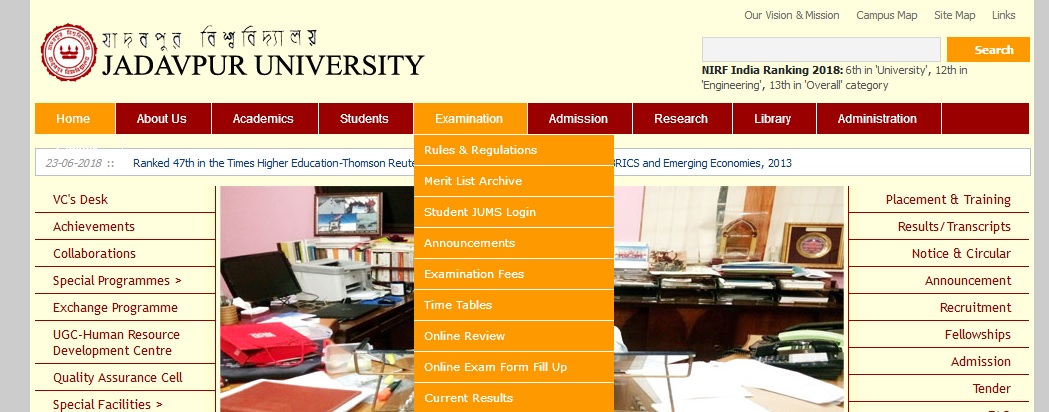Advanced Biochemical Engineering M.Tech Question Paper : jaduniv.edu.in
Name of the University : Jadavpur University
Department : Food Tech & Bio-Chemical Engineering
Degree : M.Tech
Subject Name : Advanced Biochemical Engineering
Sem : I
Website : jaduniv.edu.in
Document Type : Model Question Paper
Download Model/Sample Question Paper : https://www.pdfquestion.in/uploads/dspace.jdvu.ac.in/6574-Advanced%20Biochemical%20Engineering.pdf
Jadavpur Biochemical Engineering Question Paper
Master Of Technology In Food Tech. & Biochemical Engineering Examination, 2012 :
( 1st Semester )
Time : Three Hours
Full Marks : 100
** 50 marks for each Part
** Use a separate Answer Script for each Part
Related : Jadavpur University Cereal Process Engineering M.Tech Question Paper : www.pdfquestion.in/6572.html
Part – I
Answer any Two questions from Group A and One question from Group B :
Group A :
1. Deduce the heat transfer relationship with respect to heating and colling of medium undergoing fermentation in a bioreactor, considering Newton’s law of heat transfer. 16
2. Discuss the different physical mechanisms of collection of aerosol by fibrous media. Discuss one of the mechanisms by which air becomes sterile.
3. Write short notes on (any two)
i) Discuss the importance of Monod equation in case of batch fermentation.
ii) Discuss in brief the function of the occessories associated with a fermenter with the help of a neat sketch.
iii) Design of a culture medium.
iv) Importance of screenins to find out suitable microbial cultures of industrial importance.
4. a) Discuss the kinetics of cell death with respect to sterilization in Batch and continuous fumenter. 8
b) With the help of the typical bacterial growth cycle state the importance of exponential growth phase with mathematical expression. 8

Group B
5. a) State the basic sterilization equation and draw the time temperature profiles for constant degree of sterilization and deactivation of microbes. 6
b) The initial cell count presterilization is 2 x 104 cells / ml and the media volume is 9000 litres. The heating from 100oC to 121oC (the holding temperature) takes 15 min and cooling down to 100oC takes 20 min. Calculate holding time. (Table supplied) 10
6. Glucose was added to a batch culture of micro-organisms and removal was measured over time. With the help of the following data determine the reaction order of the removal process and calculate the value of constant. Establish the reaction rate equations for 0, 1 and 2 orders reaction and then predict the order of reaction by graphical methods (3 different graphs are to be drawn). 16
Part – II
Answer any Three questions. :
All questions cary equal marks. :
7. a) A bacterial fermentation was carried out in a reactor containing a medium having a density of 1.2 x 103 kg/m3 and a viscosity of 0.02 NS/m. The broth was agitated with the help of an impeller having a speed of 90 rpm and air was introduced through the sparger at the rate of 0.04 wm. The fermenter, equipped with two sets of flat blade turbines and four baffle plates was having the following dimensions.
Dimeter of fermenter = 4 m
Dia of the impeller = 2 m
Baffle plate width = 0.4 m
Liquid depth infermenter = 6.5 m
For designing the overall fermentation process it is required to determine
a) Power requirement for ungassed system
b) Power consumption for gassed system.
c) Volumetric oxygen transfer coefficient K
b) What do you understand by orifice transition gas flow rate in a bubble column bioreactor? How it can be determined?
2. What are the resistances involved in transferring oxygen from the gas phase to a respiring cell? Discuss the effect of molecular diffusivity on mass transfer coeffifient under different hydrodyanamic conditions.
3. Discuss how the concept of local isotropic turbulance can be applied to explain the effect of high agitation intensities on the mass transfer rate at solid particle surfaces in dispersed phase reactor system?
4. How the rheological properties of microbial broth containing yeast, bacteria and filamentous fungi can be determined? How the metabolic products and age of the culture affect the rheological behaviour.
5. Write short notes on (any two)
a) Dynamic method of KL a determination
b) Bubble coalescence and break up in a bubble column bioreactor.
c) Power input in bubble column
d) Minimum impeller speed in an agitated tank reactor